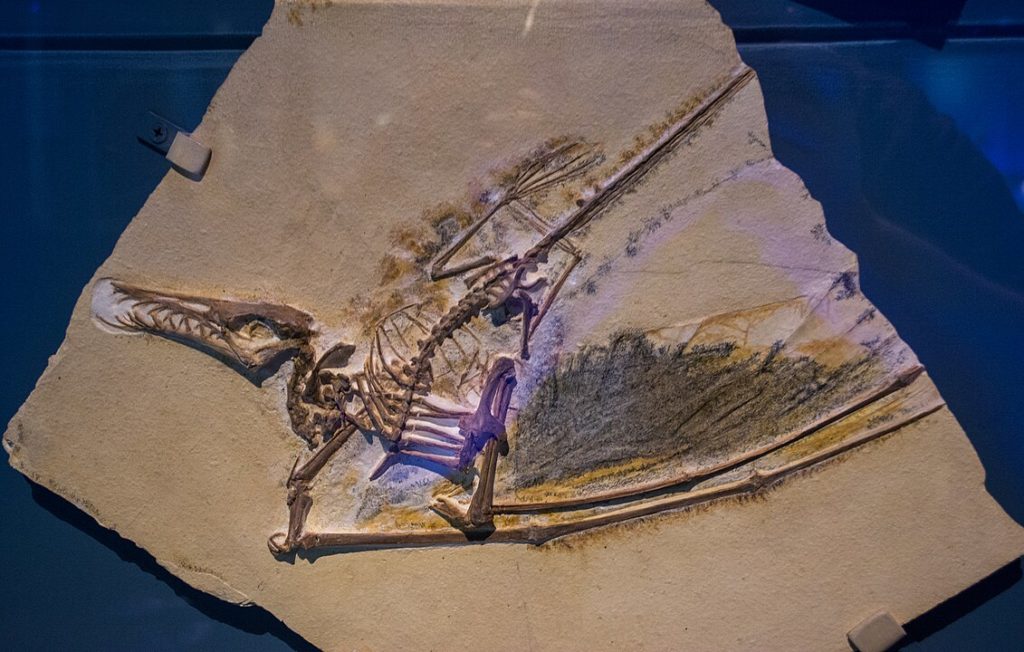
How did a pterodactyl fly? By jumping 2.5 meters into the air and then flapping.
These days, we use pterodactyl to refer to any of the flying dinosaurs that looked similar, but pterodactyl is only one species. The family is called pterosaur. In Greek, “pteron” means winged and “sauros” means lizard. Pterodactyl comes from “pteron” for winged and “dactylos” for finger.
The flying reptiles came in all different sizes, just like birds today. The smallest ones had a wingspan of 25 cm and the largest ones had a wingspan of 12 meters. When it stood upright, it would have been 3 or 4 meters tall, as tall as a giraffe, and they would have weighed 250 kg. Getting that much weight into the air to fly was a challenge. For comparison, an F-15 fighter jet has a wingspan of 13 m. The wings of many pterosaurs were so long that they had to raise them when they walked. They folded their wings up so their forearms were on the floor for balance. When they walked, they lifted one wing and moved it forward and then a rear leg before repeating with the other side. They could actually move quite fast.
All pterosaurs had wings that were an extension of their fourth finger. Their hands were fixed slightly into the wing and then the fourth finger extended along the top of the wing. This is a similar idea to a bat, except all five fingers of the bat’s hand support the wing, while only the fourth finger of the pterosaur did. Fossil evidence shows that wing probably extended down and attached to the pterosaur’s ankle. It has been pretty difficult to work out the shape of the wings because flesh and cartilage don’t become fossils. There are a few examples where the shape of the wing has been preserved. If the animal dies, and the mud or ash or whatever is surrounding the dead animal makes a solid enough mold of the animal, it can become filled with sediment and leave a fossil of softer things. This is how we can have fossils of jellyfish and leaves.
So, how did a pterodactyl, or a pterosaur fly? The secret is in their wings, their bones, and how they launched themselves into the air. Let’s look at the bones first. All of the large dinosaurs had hollow bones, which is how they could grow so big, but that was especially true for the flying dinosaurs. Their bones were hollow tubs supported by a honeycomb style frame inside. This made them light, strong, and flexible. The outside of the bone was very thin, sometimes no thicker than a piece of paper. This is one of the reasons why pterosaur fossils are so difficult to find. The bones are so thin that they are destroyed before they can become fossils.
Their wings are obviously very important. They were large to give the heavy animals as much lift as possible and they had huge breastbones to hold the enormous muscles needed to flap those wings. Their arm bones had big lumps where those muscles connected. They also had wings that were very well supported but that could also fold up easily. When the fossil with the intact wings of the pterosaur was found, close analysis showed that there were long fibers that stretched from the front of the wings to the back. The wings were flaps of skin, but when they were extended, these fibers strengthened them and helped support the animal more. Paleontologists were also able to see the blood vessels that carried blood to the wings.
There is no way of knowing for sure, but pterosaurs probably flew by launching themselves into the air and then flapping. They had powerful legs and they could use their forelegs and the wing muscles as well. They could probably have jumped 2 or 3 meters into the air fairly easily, and started to flap from there. When they were airborne, they most likely flew in the same way as the big birds that are around today, such as the albatross. These birds glide more than flap and ride thermals and updrafts.
Pterosaurs probably evolved the ability to glide before they were able to fly. They could probably glide from tree to tree or from a high place to swoop down on prey. Once they had evolved this ability, they seem to have evolved wings that could flap, so they could go higher and find more prey. And this is what I learned today.
Image By Tim Evanson – https://www.flickr.com/photos/timevanson/45708566502/, CC BY-SA 2.0, https://commons.wikimedia.org/w/index.php?curid=74203950
Sources
https://cosmosmagazine.com/history/palaeontology/how-did-the-worlds-largest-pterosaur-fly/
https://www.amnh.org/exhibitions/pterosaurs-flight-in-the-age-of-dinosaurs/how-did-pterosaurs-fly
https://en.wikipedia.org/wiki/Pterosaur
https://www.amnh.org/exhibitions/pterosaurs-flight-in-the-age-of-dinosaurs/what-is-a-pterosaur
https://www.britannica.com/technology/F-15
https://www.sciencemill.org/blog/how-did-pterosaurs-fly
https://www.newhopeaudubon.org/blog/magnificent-wandering-albatrosses/
